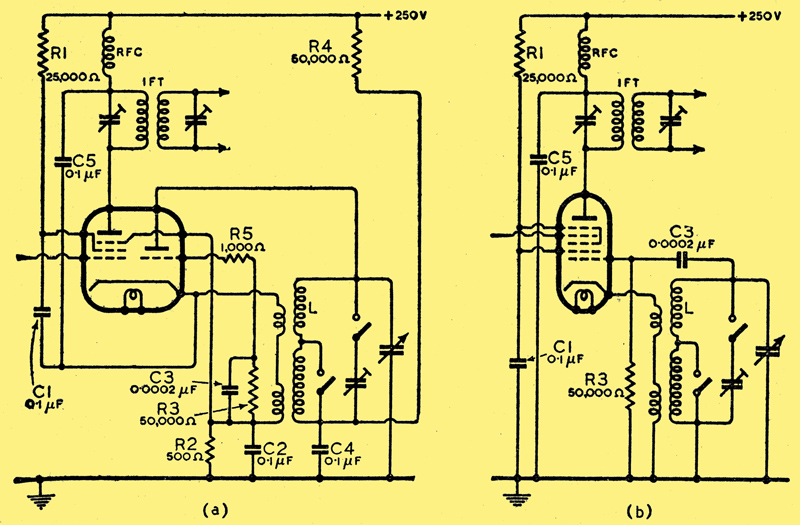|
Heptode ass a substitute.
The triode-pentode has been used in many receivers as a frequency changer, and now that supplies are very limited the replacement of this valve has caused a serious problem. Several circuit modifications have already been suggested, and this note shows how a heptode may be used.

Diagram (a) represents a typical frequency-changing circuit with a triode-pentode valve; the use of a heptode as a replacement is shown at (b).
A typical mixer circuit using a triode-pentode is shown in diagram (a); cathode, injection of the oscillator frequency is used. This circuit may be rearranged as shown in diagram (b) to permit the use of a heptode such as the Marconi or Osram MX40, X42 or X63; other valves having similar characteristics may also be used with this arrangement, which is identical to that recommended for the 6SA7.
The normal oscillator anode (G2) is joined to the screen (G3-5), and this is used as the oscillator anode; the tuned circuit L being connected in the oscillator grid (G1) circuit instead of to the oscillator anode as is usual with the triode-pentode.
The following modifications will be needed:-
- Change 9-pin socket to 7-pin.
- Remove R2, R3, R4, R5, also C2 and C4.
- Connect C1 and C5 to earth instead of to cathode.
- Earth end of cathode coil that used to go to C2, R2.
- Join oscillator anode to screen.
- Connect oscillator coil to oscillator grid via 0.0002 μF capacitor C3.
- Connect 50,000 Ω resistance R3 from oscillator grid to earth.
- Re-align receiver.
The RF choke is, strictly speaking, no longer required, but will do no harm if it is left in place; the other components removed are not required in the modified circuit.
The success of, this rearranged circuit is no doubt due to the comparatively high mutual conductance of the oscillator triode, formed by the oscillator grid (G1) and the screen grid (G3-5), being much higher than when the heptode is used in the normal way with G2 as the anode.
The choice of heptodes available is considerable and in an AC receiver any of them should be satisfactory, though one with a four-volt heater is most convenient; but, providing a suitable heater supply is provided, those with other ratings may be used. For use in an AC/DC receiver it is essential to select one having the correct heater current rating; a small difference in heater voltage rating can be ignored.
|